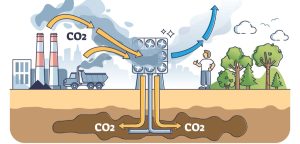Tech and Climate Change: How Innovation Drives a Sustainable Future
In recent years, technology has been both a contributor to and a potential solution for climate change. While the tech industry is responsible for a significant share of global carbon emissions, innovations such as renewable energy adoption, carbon capture, and AI-driven climate solutions offer hope for sustainable development. This article explores the complex relationship between tech and climate change, diving into the impact of data centers, carbon-neutral technology, and real-life case studies demonstrating tech’s role in mitigating climate effects.
Understanding the Impact of Data Centers on Climate Change

Data centers are the backbone of the digital economy, supporting everything from cloud storage to AI operations. However, they also represent a significant environmental challenge:
Emissions and Energy Consumption:
Data centers consume vast amounts of electricity, with a single large data center using the equivalent energy of a small town. In the U.S. alone, data centers consumed about 70 billion kWh in 2014, accounting for nearly 1.8% of total electricity use.
Carbon Emissions:
The electricity demand from these facilities often comes from non-renewable sources, leading to high carbon emissions. Tech giants are now focusing on reducing their carbon footprints by shifting to renewable energy sources and implementing carbon capture technologies.
Google’s Carbon-Neutral Data Centers
Google has made significant strides toward creating carbon-neutral data centers. By investing in renewable energy projects like large-scale solar farms in Texas, Google aims to run all its data centers on carbon-free energy by 2030. These efforts are part of the company’s broader commitment to sustainability, demonstrating how tech companies can reduce their environmental impact through strategic investments.
Tech Companies Investing in Renewable Energy
Renewable energy adoption by tech firms has become a key driver in the fight against climate change. Major companies like Amazon, Microsoft, and Apple have committed to renewable energy projects, aiming to minimize their operational carbon footprints.
Amazon’s Solar Initiatives:
Amazon is a leading investor in renewable energy, with over 206 projects globally, including wind and solar farms. By 2025, Amazon aims to power its operations entirely with renewable energy.
Apple’s Global Clean Energy Program:

Apple has pushed for renewable energy adoption across its supply chain, requiring its suppliers to commit to 100% renewable energy for Apple-related production. This initiative has contributed to reducing overall tech industry emissions.
Benefits of Renewable Energy in the Tech Sector
- Reduced Carbon Footprint: Shifting to renewable energy sources like wind, solar, and hydro reduces reliance on fossil fuels, significantly lowering greenhouse gas emissions.
- Operational Cost Savings: While the initial investment in renewable energy can be high, tech companies often see long-term cost savings due to lower energy costs.
- Enhanced Brand Reputation: Adopting clean energy strategies helps tech companies align with public demand for sustainability, boosting their brand image.
The Role of AI in Combating Climate Change
AI for environmental monitoring has emerged as a promising technology to combat climate change. AI algorithms can analyze large data sets to identify climate patterns, predict natural disasters, and suggest resource optimization strategies.
AI for Climate Monitoring:
Terahertz communication technologies are being explored for climate sensing. These advancements allow for better climate predictions, improved disaster preparedness, and faster responses.
Microsoft’s AI for Earth Program

Microsoft’s AI for Earth program exemplifies the use of AI for sustainable development. It provides grants and resources to organizations working on AI solutions to address agricultural sustainability, biodiversity, water conservation, and climate change. AI-driven insights from these projects have helped track deforestation rates, optimize water usage, and enhance carbon capture efforts.
Benefits of AI for Climate Adaptation
- Improved Climate Predictions: AI technologies can offer accurate predictions of weather patterns, helping communities prepare for climate-related events like floods and hurricanes.
- Resource Optimization: AI helps industries optimize resource usage, such as energy, water, and raw materials, contributing to more efficient operations.
- Real-Time Monitoring: AI solutions enable real-time monitoring of emissions, allowing companies to track and reduce their carbon footprint more effectively.
Nuclear Energy for Data Center Sustainability
The tech industry has started exploring nuclear energy as a carbon-neutral option to power data centers and AI operations. Small modular nuclear reactors (SMRs) have gained attention due to their potential to provide consistent, clean energy.
Carbon-Neutral Technology:
Nuclear energy emits zero carbon during electricity production, making it a viable option for achieving sustainability in tech operations.
Amazon and Google’s Nuclear Investments
Both Amazon and Google have invested in SMRs to meet the growing energy demands of AI and data centers. These nuclear technologies can provide stable, clean energy, helping these companies maintain sustainability while supporting expanding digital infrastructure.
Benefits of Nuclear Energy for Tech Companies
- Reliable Energy Source: Unlike solar or wind, nuclear energy provides a continuous power supply, crucial for data centers that require constant uptime.
- Zero Carbon Emissions: By replacing fossil fuels with nuclear power, tech firms can significantly reduce their carbon emissions.
- Increased Energy Security: Nuclear energy helps enhance energy security by reducing dependence on fluctuating fossil fuel markets.
Carbon Capture Advancements in the Tech Sector
Carbon capture technologies focus on capturing and storing CO₂ emissions from industrial activities, including tech infrastructure.
Carbon Capture Initiatives by Climeworks:

Climeworks is a leading company in the field of carbon removal. It captures CO₂ directly from the air and stores it underground, providing an innovative solution for reducing atmospheric carbon levels.
Benefits of Carbon Capture for Climate Tech
- Reduces Atmospheric CO₂: Carbon capture technology can directly reduce CO₂ levels in the atmosphere, a crucial step toward reversing climate change.
- Integrates with Existing Infrastructure: These technologies can be installed in existing data centers and industrial sites, making them scalable solutions for carbon neutrality.
- Enhances Climate Tech Innovation: Investing in carbon capture drives further innovation, encouraging the development of more efficient and cost-effective carbon removal solutions.
Challenges and Future of Tech-Driven Climate Solutions
While technology offers significant tools for addressing climate change, challenges remain:
- High Initial Costs: The transition to renewable energy, AI infrastructure, and carbon capture can be capital-intensive.
- Regulatory Hurdles: Government regulations and policies often lag behind technological advancements, slowing down the implementation of climate tech solutions.
- Balancing Growth and Sustainability: Rapid tech growth can sometimes conflict with sustainability goals, requiring a careful balance between development and environmental impact.
Looking Ahead: The Path to Sustainable Tech
For the tech industry to lead the fight against climate change, a comprehensive approach is needed. This includes investing in clean energy, developing AI-driven climate solutions, adopting nuclear technologies for consistent energy supply, and expanding carbon capture initiatives. Collaboration among tech companies, governments, and research institutions is critical to accelerating these efforts.
Conclusion
Technology’s relationship with climate change is multifaceted. While it has historically contributed to emissions, it also offers groundbreaking solutions for a sustainable future. Through renewable energy adoption, AI innovations, and carbon capture advancements, tech companies can play a central role in global climate adaptation and mitigation strategies. By integrating sustainable practices into their operations, tech firms can lead the way in creating a more resilient world for future generations.









